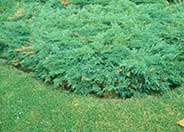
Common name:Scandia Juniper
Botanical name:Juniperus sabina 'Scandia'
Juniperus sabina 'Scandia' has dense, bright green foliage. It grows to 1' high and 6'-8' wide. This plant is a ground cover. Junipers are highly combustible plants.

Common name:Red Leaf Japanese Barberry
Botanical name:Berberis thunbergii 'Atropurpurea'
A thorny, deciduous shrub growing 4'-6' high and as wide, Red Japanese Barberry can be contained with some light pruning. Its purplish-red leaves contrast beautifully against a dark green background.

Common name:Natal Plum
Botanical name:Carissa macrocarpa
The Natal Plum can be grown as a foliage plant or a flowering plant, and the flowers bloom intermittently with red fruit. The flowers must be pollinated by hand placed where bees can reach them in order to produce fruit.

Common name:Frades or Compact Escallonia
Botanical name:Escallonia X exoniensis 'Frades'
The 'Frades' is an evergreen shrub that grows to 6'-8' tall and wide. It is valued for its glossy foliage and clusters of pink flowers. The heaviest bloom period is during spring and fall, with some flowers all year. The Escallonias grow best in sun to part shade, but will tolerate mostly shade if necessary. These plants usually need little or no summer watering. This is the most tolerant of poor drainage of all Escallonia varieties. -Monterey Bay Nursery

Common name:Dwarf Japanese Garden Juniper
Botanical name:Juniperus procumbens 'Nana'
The very dense growth of this plant is highlighted by foliage of a bluish green color. Its growth habit is very low, spreading, and mound-like, resembling a natural bonsai. This variety is one of the best Junipers for small garden spaces. Junipers are highly combustible plants.
Pest Management
Are pests bugging you? If pests are taking over there might be a good reason! Instead of grabbing that bottle of spray, consider using techniques that can solve your pest problems without toxic pesticides.
Click in the green box for more information
| Designer: Pam Pavela | Lawn Substitute No More Mower |
Photographer: GardenSoft |
Soils and Compost:
Practice grass-cycling by leaving short grass clippings on lawns after mowing, so that nutrients and organic matter are returned to the soil.
Water Saving Tip:
Be sure to fix all leaks promptly no matter how small they may seem.
Integrated Pest Management:
Develop healthy soil for plants that are vigorous and naturally pest-resistant.

